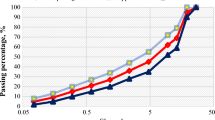Abstract
Environmental waste caused by technological and industrial development is increasing. In Egypt, tens of thousands of tons of industrial waste are disposed of each year. One of the cheapest and most effective ways to eliminate such waste and protect the environment is recycling in hot mix asphalt (HMA) mixture. We carried out a laboratory investigation into the effects of different fillers on some properties of such HMA mixtures, considering two types of industrial and byproduct waste filler, namely ceramic waste dust (CWD) and marble waste dust (MWD). Ceramic waste dust (CWD) was enhanced using cement dust at 1:1 ratio to remove its plasticity. Lime stone dust (LSD) was used as control filler. Subsequently, 17 HMA specimens were prepared using the Marshall mix design method for wearing surface mix (mix 4C). Marshall stability (MS) and flow tests were applied to the specimens, and MS and flow values recorded. For the optimum bitumen content (OBC) and different waste ratios, the Marshall parameters were determined. Then, some special tests were performed to measure the different mix characteristics, including loss of stability and wheel tracking tests. The results led to important conclusions regarding use of ceramic waste dust (CWD) enhanced by cement dust and marble waste dust (MWD) to improve most of the properties of HMA mixtures. Finally, this study recommends a proposed mix with mineral filler formed of 35 wt.% CWD enhanced by cement dust or 15 wt.% MWD respectively.


Similar content being viewed by others
References
Kalkattawi HR (1993) Effect of filler on the engineering properties of asphalt mixes, M.S. Thesis King Abdul Aziz University, Jeddah, Saudi Arabia
Prithvi S Kandhal, Lynn Y, Parker F Jr (1998) Characterization tests for mineral fillers related to performance of asphalt paving mixture, Auburn University, Alabama, NCAT Report No. 98–2
Sutradhar D, Miah M, Golam JC, Mohd AS (2015) Effect of using waste material as filler in bituminous mix design. Am J Civ Eng 3(3):88–94
Do HS, Mun PH, keun RS (2008) A study on engineering characteristics of asphalt concrete using filler with recycled waste lime. Waste Manage 28:191–199
Katamine NM (2000) Phosphate waste in mixtures to improve their deformation. J Transp Eng 126:382–389
Yongjie X, Haobo H, Shujing Z, Jin Z (2009) Utilization of municipal solid waste incineration ash in stone mastic asphalt mixture: pavement performance and environmental impact. Constr Build Mater 23:989–996
Deng-Fong L, Jyh-Dong L, Shun-Hsing C (2006) The application of baghouse fines in Taiwan. Resour Conserv Recycl 46:281–301
Ibrahim A (2005) Assa’ad Abdullah: effect of Jordanian oil shale fly ash on asphalt mixes. J Mater Civ Eng 17:553–559
Baoshan H, Qiao D, Burdette EG (2009) Laboratory evaluation of incorporating waste ceramic materials into Portland cement and asphaltic concrete. Constr Build Mater 23:3451–3456
Bilgin N, Yeprem HA, Arslan S, Bilgin A, Gunay E, Marşoglu M (2012) Use of waste marble powder in brick industry. Constr Build Mater 29:449–457
Abdel-Motaleb ME (2007) Impact of high- pressure truck tires on pavement design in Egypt. Faculty of Engineering, Zagazig University. Emir J Eng Res 12(2):65–73
Ustunkol FN, Turabi A Endüstriyel atıkların karayolu üstyapısında değerlendirilmesi
Saatcioglu G (2010) Türk Seramik Sanayi Raporu 1990–2009 yullari. Turkish ceramics federation, Istanbul
Pacheco-Torgal F, Jalali S (2010) Reusing ceramic wastes in concrete. Constr Build Mater 24:832–838
Van de Ven M, Molenaar A, Poot M (2011) Asphalt mixtures with waste materials: possibilities and constraints. Conference on asphalt pavements for Southern Africa [CAPSA11]
Karasahin M, Terzi S (2007) Evaluation of marble waste dust in the mixture of asphaltic concrete. (Regular Papers). J Sci Direct 21(3):616–620
West RC, James RS (2006) Evaluation of a lime kiln dust as a mineral filler for stone matrix asphalt, Proceedings of National Center for Asphalt Technology. In: The 85th Annual Meeting of the Transportation Research Board, Washington, D.C., Accessed Jan 2006
Tuncan M, Tuncan A, Cetin A (2005) The use of waste materials in asphalt concrete mixtures. Anadolu University, Department of Civil Engineering. J Waste Manag Res 23:550–559
AASHTO T166 (2013) Standard method of test for bulk specific gravity (Gmb) of compacted hot mix asphalt (HMA) using saturated surface-dry specimens. American Association of State Highway and Transportation Officials, Washington
Laboratory Tests Guide (2015) General authority for roads, bridges and land transport, Egypt
Author information
Authors and Affiliations
Corresponding author
Rights and permissions
About this article
Cite this article
Eisa, M.S., Basiouny, M.E. & Youssef, A.M. Effect of using various waste materials as mineral filler on the properties of asphalt mix. Innov. Infrastruct. Solut. 3, 27 (2018). https://doi.org/10.1007/s41062-018-0129-4
Received:
Accepted:
Published:
DOI: https://doi.org/10.1007/s41062-018-0129-4




